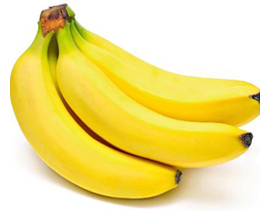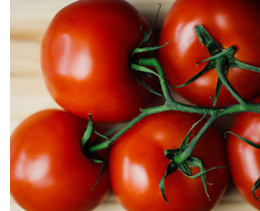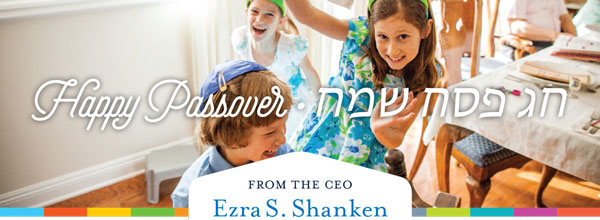This message has 802 words and will take about 5 minutes to read.
It wouldn’t surprise me if the youngest person at our seder tonight was unable to resist asking a fifth question: why is there a banana, an orange, a tomato and a chocolate bar on the Shanken family seder plate?
 I was recently reminded by Rabbi Moscovitz of a seemingly minor note in the tragic “modern exodus” in which Syrian child, Aylan Kurdi, his brother Galib, and their mother Rihan lost their lives. Before the Kurdi family fled Syria in search of peace and freedom, Aylan and Galib’s father, Abdullah, made sure his boys had one little treat every day, a banana. This loving father, unable to provide his boys with the things that were in abundance before the war, bought them one banana to share each day. When he returned to Kobane to bury them, he spoke of wanting to leave bananas at their graves. And so, the banana found its way onto our seder plate. I was recently reminded by Rabbi Moscovitz of a seemingly minor note in the tragic “modern exodus” in which Syrian child, Aylan Kurdi, his brother Galib, and their mother Rihan lost their lives. Before the Kurdi family fled Syria in search of peace and freedom, Aylan and Galib’s father, Abdullah, made sure his boys had one little treat every day, a banana. This loving father, unable to provide his boys with the things that were in abundance before the war, bought them one banana to share each day. When he returned to Kobane to bury them, he spoke of wanting to leave bananas at their graves. And so, the banana found its way onto our seder plate.
It reminded me of when I worked in New York, and I canvassed a young woman who had visited Israel on a program similar to Taglit-Birthright Israel but that was specifically for young Russian Jews. I asked what her most pivotal experience there had been. Was it her first visit to the Kotel? No. Perhaps when the plane landed and her feet first touched Israeli soil? No, it wasn’t that either. She said the program organizers had flown her from Riga to Cyprus, and they’d taken a boat the rest of the way to Israel. Wow, I said, just like on the Exodus; no wonder it made such an impact on her. Not exactly, she said.
On the boat ride, someone from our partner agency, The Jewish Agency for Israel, had given her a snack - a banana – and this was the big moment that stuck with her. It was the moment her life changed. Exotic, tropical fruit was an unimaginable luxury where she grew up, and to be handed one so casually was emblematic of the opportunities and freedoms that were opening up for her. At our seder, the banana symbolizes the plight of people around the world today who yearn for a better life.
 Many of us talk about modern forms of enslavement at the seder, and we like to highlight the plight of migrant farm workers. We chose a vegetable (OK, technically a fruit) not already part of the Passover tradition to represent them. This is how the tomato joined our seder plate. Recently, I learned about the enslavement of Western African children who harvest cocoa, and so now fair trade chocolate will join our seder plate. Many of us talk about modern forms of enslavement at the seder, and we like to highlight the plight of migrant farm workers. We chose a vegetable (OK, technically a fruit) not already part of the Passover tradition to represent them. This is how the tomato joined our seder plate. Recently, I learned about the enslavement of Western African children who harvest cocoa, and so now fair trade chocolate will join our seder plate.
You need not be enslaved to have your freedoms curtailed; it is enough simply to be marginalized. We include an orange to represent the evolution of women’s rights and to recognize the LGBTQ members of our community. We also highlight the role of the women of the Exodus story by setting Miriam’s cup next to Elijah’s. After all, "If it weren’t for the righteousness of women of that generation we would not have been redeemed from Egypt" (Babylonian Talmud, Sotah 9b).
The youngest at our seder might also look at the empty seat at the table and ask who it’s for. As we recall the ten plagues brought on our behalf, we remember that the plague of loss and terror is still very much with us when it comes to Israel and the lives of global Jewry. We leave one seat empty to acknowledge those whose lives were lost in wars and terror attacks. Just this week there was the horrific bombing of a bus in Jerusalem that injured at least 20 people. Ours is a community that has felt loss, and many families have been directly affected and lost loved ones in the wars and terror attacks that have plagued Israel since its inception. If you wish to stand with these families and show your support, our Yom Hazikaron memorial is an opportunity to do so. And if you wish to leave one seat open at your seder table, I commend your participation.
Tonight, as we welcome Shabbat and Pesach together, I am still thinking about the d'var with which Rabbi Infeld opened our Board meeting on Monday. He spoke of the messianic undertones of the seder and the haggadah, and said there are two theories about the bringing of the Mashiach (and I’m paraphrasing): one is that He will come in the world’s most turbulent time, and the other is that He will come when the world is nearly perfect. So, when the youngest asks why we have all these unusual things at our seder table, it will be an opportunity to talk about our freedom to choose to live our lives in pursuit of a better world that one day will near perfection.
Shabbat shalom and chag Pesach sameach,
Ezra S. Shanken
CEO,
Jewish Federation of Greater Vancouver |

